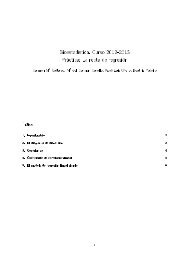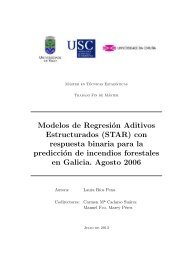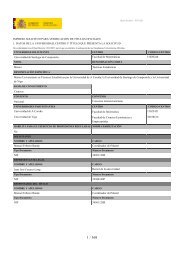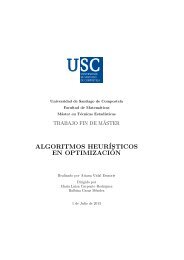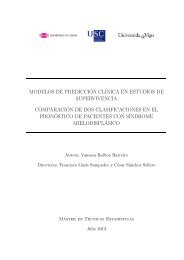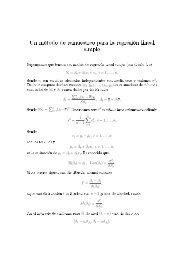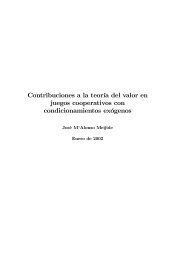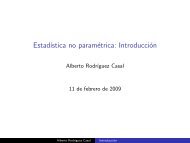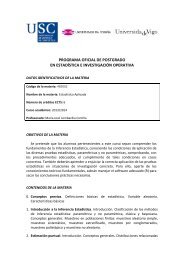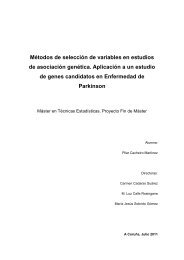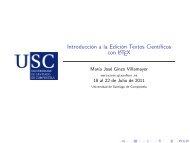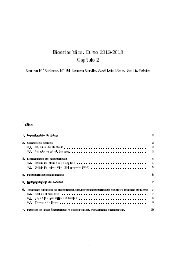Bootstrap independence test for functional linear models
Bootstrap independence test for functional linear models
Bootstrap independence test for functional linear models
Create successful ePaper yourself
Turn your PDF publications into a flip-book with our unique Google optimized e-Paper software.
2.2 Linear <strong>independence</strong> <strong>test</strong>Given a generic H–valued random element H such that E(‖H‖ 2 ) < ∞, its associated covarianceoperator Γ H is defined as the operator Γ H : H → HΓ H (h) = E (〈H − µ H , h〉(H − µ H )) = E (〈H, h〉H) − 〈µ H , h〉µ H ,<strong>for</strong> all h ∈ H, where µ H ∈ H denotes the expected value of H. From now on, it will be assumedthat E(‖X‖ 2 ) < ∞, and thus, as a consequence of Hölder’s inequality, E(Y 2 ) < ∞. Wheneverthere is no possible confusion, Γ X will be abbreviated as Γ. It is well–known that Γ is a nuclearand self–adjoint operator. In particular, it is a compact operator of trace class and thus, in virtueof the Spectral Theorem Decomposition, there is an orthonormal basis of H, {v j } j∈N , consisting oneigenvectors of Γ with corresponding eigenvalues {λ j } j∈N , that is, Γ(v j ) = λ j v j <strong>for</strong> all j ∈ N. Asusual, the eigenvalues are assumed to be arranged in decreasing order (λ 1 ≥ λ 2 ≥ . . .). Since theoperator Γ is symmetric and non–negative definite, then the eigenvalues are non–negative.In a similar way, let us consider the cross–covariance operator ∆ : H → R between X and Y givenby∆(h) = E (〈X − µ X , h〉(Y − µ Y )) = E (〈X, h〉Y ) − 〈µ X , h〉µ Y ,<strong>for</strong> all h ∈ H, where µ Y ∈ R denotes the expected value of Y . Of course, ∆ ∈ H ′ and the followingrelation between the considered operators and the regression parameter Θ is satisfied∆(·) = 〈Γ(·), Θ〉. (4)The Hilbert space H can be expressed as the direct sum of the two orthogonal subspaces inducedby the self–adjoint operator Γ: the kernel or null space of Γ, N (Γ), and the closure of the image orrange of Γ, R(Γ). Thus, Θ is determined uniquely by Θ = Θ 1 +Θ 2 with Θ 1 ∈ N (Γ) and Θ 2 ∈ R(Γ).As Θ 1 ∈ N (Γ), it is easy to check that V ar(〈X, Θ 1 〉) = 0 and, consequently, the model introducedin (1) can be expressed asY = 〈Θ 2 , X〉 + 〈Θ 1 , µ X 〉 + b + ε.There<strong>for</strong>e, it is not possible to distinguish between the term 〈Θ 1 , µ X 〉 and the intercept term b,and consequently it is not possible to check whether Θ 1 = 0 or not. Taking this into account, thehypothesis <strong>test</strong> will be restricted to check{H0 : Θ 2 = 0(5)H 1 : Θ 2 ≠ 0on the basis of the available sample in<strong>for</strong>mation.Note that in this case, according to the relation between the operators and the regression parametershown in (4), Θ 2 = 0 if, and only if, ∆(h) = 0 <strong>for</strong> all h ∈ H. Consequently, the hypothesis <strong>test</strong> in(5) is equivalent to{H0 : ‖∆‖ ′ = 0H 1 : ‖∆‖ ′ (6)≠ 0Remark 1. It should be recalled that, in previous works µ X is assumed to be equal 0. Thus,the preceding reasoning leads to the fact that Θ 1 cannot be estimated based on the in<strong>for</strong>mationprovided by X (see, <strong>for</strong> instance, Cardot, Ferraty, Mas, and Sarda (2003)). Consequently thehypothesis <strong>test</strong>ing is also restricted to the one in the preceding equations. In addition in Cardot,Ferraty, Mas, and Sarda (2003), it is also assumed <strong>for</strong> technical reasons that R(Γ) is an infinite–dimensional space. On the contrary, this restriction is not imposed in the study here developed.4



